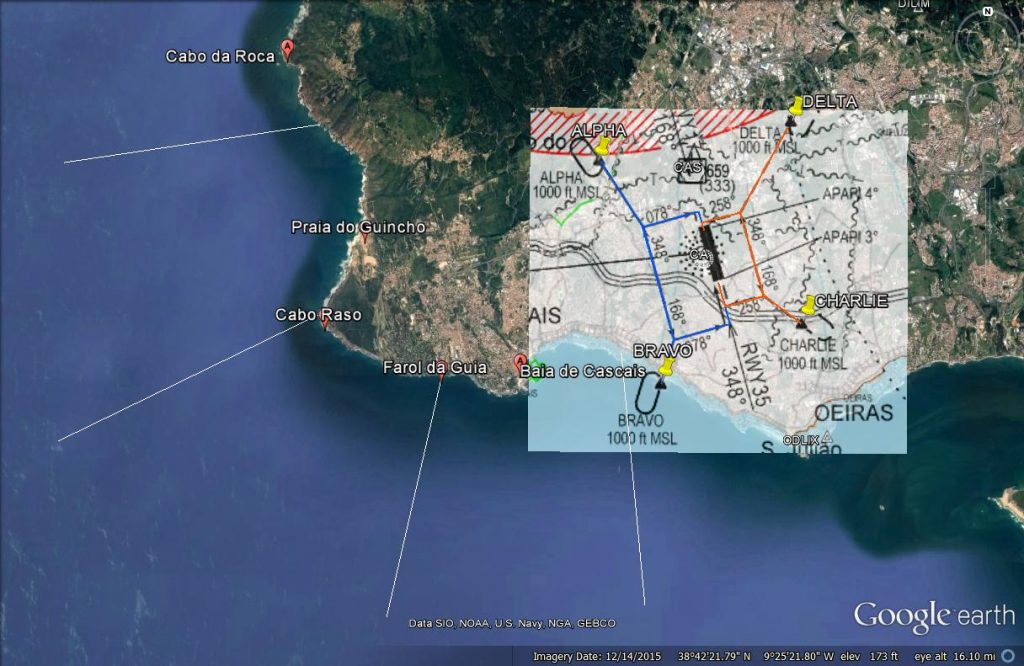Airspace Characteristics
Cascais CTR is a Class C airspace, extending from Surface to 1500ft on the 5NM circle centered on ARP, excluding the portion of airspace on the north by the Restricted area LPR42A, and on the west part where the airspace from the 9NM circle of LPPT ARP overlaps, having a top of 1000ft.
The aerodrome transition altitude is 4000ft, and transition level is in function of QNH
Runway configuration
Preferred runway is 35 for departure and arrival, wind permitting.
Runway 35 is the only runway with a non-precision navaid available for arrival, Cascais / CAS VOR
If Runway 17 is in use, and the pilot is arriving using IFR, a VOR approach to runway 35 is done with a circle to land, preferably on the west side of the aerodrome.
Significant VFR Points and Areas
In Cascais CTR there are four main significant VFR Points:
✈ ALPHA – Autódromo do Estoril
✈ BRAVO – Ponta do Sal
✈ CHARLIE – Bairro do Pinhal
✈ DELTA – Nó de Paiões (IC19)
These significant waypoints are used as a way to hold or delay airships on the air with a VFR flight plan, when entering the aerodrome circuit or when a traffic with an IFR approach is arriving.
There are also 3 secondary VFR Points:
✈ Cabo da Roca – Entry and Exit Point for flights to/from the North
✈ Cova do Vapor – Exit Point for flight going to the south of Cascais and entering Lisboa TMA VFR Tunnels
✈ Farol do Bugio – Entry Point for flights coming from the south of Cascais and exiting Lisboa TMA VFR Tunnels
✈ Carcavelos – Significant Point that serves as reference for a long final approach to runway 35
In Cascais CTR we can find three Working Areas.
✈ Guincho
✈ Cabo Raso
✈ Baia de Cascais / Cascais bay
These areas are mainly used for light traffic to perform training maneuvers, such as slow flight, coordinated turn, climbs and descents, since Cascais is an aerodrome that serves multiple flight schools.
The following image depict the referred VRP:
Local Procedures
If runway 35 is active, circuits for fixed wing aircrafts are done on the left hand and circuits for rotary wing are done on the right hand. Oppositely, if runway 17 is active, circuits for fixed wing aircrafts are done one the right hand and circuits for rotary wing are done on the left hand.
Aerodrome circuit altitude is 1000ft AMSL (QNH).
Aircraft leaving the CTR is normally cleared to 1000ft, Aircraft entering the CTR is normally cleared at 1500ft.
If a traffic is proceeding to the tunnels after departure,
When runway 35 is in use – traffic will be cleared by the right after departure, avoiding conflicts with traffic performing local patterns on the standard left hand side.
When runways 17 is in use – traffic will be cleared by the left direct to Cova do Vapor.
If a traffic intends to leave the CTR to the North, which it’s normally done via Cabo da Roca, it will be cleared to turn left/right (depending on runway in use) direct to Cabo da Roca after departure
For traffic that will remain on local circuit or intend to go to a working area, clearance will be given to join the circuit or proceed to the available working area.
On an important note, traffic that will remain on circuit will not have any transponder code assigned (must use the General VFR / 7000) and maintain Mode Stand-by at all times.
Phraseology examples
For the VFR purpose, Pilot will be flying a C152 with registration CS-AVC and we will assume both Ground and Tower positions are active. Runway in use is 35.
Traffic for Local Patterns
CSAVC – Cascais Ground, bom dia, CSAVC at apron A request start-up
GND – CSAVC, bom dia, start-up approved, runway 35 in use, wind 320 at 10, QNH 1020
CSAVC – start-up approved, runway 35, QNH 1020, CSAVC
—
CSAVC – Ground, CSAVC ready to copy for local circuits, and request taxi
GND – CVC, cleared from Cascais to Cascais, after departure turn left join downwind runway 35, 1000 feet
CSAVC – cleared from Cascais to Cascais, after departure turn left join downwind runway 35, 1000 feet, CVC
GND – CVC readback correct, taxi holding point runway 35
CSAVC – taxi holding point runway 35, CVC
—
CSAVC – Ground, CVC reaching holding point runway 35
GND – CVC contact Cascais Tower on 120.300, bom dia
CSAVC – Contacting Tower 120.300, CVC obrigado
—-
CSAVC – Cascais Tower, bom dia, CSAVC at holding point runway 35 ready for departure
TWR – CSAVC, bom dia, wind 320 at 10, runway 35 cleared for take off
CSAVC – runway 35, cleared for takeoff CSAVC
After that, it’s business as usual, with the pilot reporting on downwind the intention for next approach / touch-and-go, stop-and-go, full stop, low pass etc..
Traffic for Working areas / Leaving CTR
CSAVC – Cascais Ground, bom dia, CSAVC at apron A request start-up
GND – CSAVC, bom dia, start-up approved, runway 35 in use, wind 320 at 10, QNH 1020
CSAVC – start-up approved, runway 35, QNH 1020, CSAVC
—
CSAVC – Ground, CSAVC ready to copy for any available working area, and request taxi
GND – CVC, cleared from Cascais to Cascais, after departure turn left to Cabo Raso, 1000 feet, squawk 3247
CSAVC – cleared from Cascais to Cascais, after departure turn left to Cabo Raso, 1000 feet, squawk 3247, CVC
GND – CVC readback correct, taxi holding point runway 35
CSAVC – taxi holding point runway 35, CVC
—
CSAVC – Ground, CVC reaching holding point runway 35
GND – CVC contact Cascais Tower on 120.300, bom dia
CSAVC – Contacting Tower 120.300, CVC obrigado
—-
CSAVC – Cascais Tower, bom dia, CSAVC at holding point runway 35 ready for departure
TWR – CSAVC, bom dia, wind 320 at 10, runway 35 cleared for take off
CSAVC – runway 35, cleared for takeoff CSAVC
—
CSAVC – Tower, CSAVC reaching Cabo Raso at 1000ft, requesting 1500ft or bellow.
TWR – CVC maintain 1500ft or bellow
CSAVC – maintaining 1500ft or bellow, CVC
—
When pilot is ready to leave the area, and return to the airfield:
CSAVC – Cascais Tower, CVC at Cabo Raso, requesting landing instructions
TWR – CVC proceed direct to airfield, join left downwind runway 35, descend to circuit altitude
CSAVC – proceeding direct to airfield and joining left downwind for runway 35 down to circuit altitude
Alternatively, TWR can instruct the pilot to proceed to one of the VFR Points and orbit, until there is space in the circuit for the plane, or send him to Carcavelos to join final
Traffic that is leaving the CTR via North or South is pretty similar in terms of communications with the ones that go to the working areas, with the exception that a handoff exists,
Leaving by the north:
CSAVC – Cascais Tower, bom dia, CSAVC at holding point runway 35 ready for departure
TWR – CSAVC, bom dia, wind 320 at 10, runway 35 cleared for take off
CSAVC – runway 35, cleared for takeoff CSAVC
—
CSAVC – Tower, CSAVC reaching Cabo da Roca
TWR – CVC contact Sintra Approach (can also be to contact Lisboa Information/Mil), bom voo
CSAVC – Contacting Sintra Approach, CVC obrigado
Leaving by the south to the tunnels:
CSAVC – Cascais Tower, bom dia, CSAVC at holding point runway 35 ready for departure
TWR – CSAVC, bom dia, wind 320 at 10, runway 35 cleared for take off
CSAVC – runway 35, cleared for takeoff CSAVC
—
CSAVC – Tower, CSAVC reaching Cova do Vapor
TWR – CVC monitor Lisboa Approach on 119.1, bom voo
CSAVC – Monitoring Lisboa Approach on 119.1, CVC obrigado
IFR Traffic Departing
CSDTP – Cascais Ground boa tarde, CSDTP at apron D ready for IFR Clearance
GND – CSDTP boa tarde, cleared from Cascais to Valencia, after departure runway 35 follow radial 230 from CAS, climb 3000 ft, squawk 3253.
CSDTP – Cleared from Cascais to Valencia, after departure runway 35 follow radial 230 from CAS climbing 3000ft, squawk 3253.
GND – CTP readback correct.
—
CSDTP – Ground, CTP requesting start-up
GND – CTP start-up approved, QNH1018
CSDTP – start-up approved, QNH1018 CTP
—
CSDTP – Ready for taxi, CTP
GND – CTP taxi and hold short at K
CSDTP – Taxi and hold short at K, CTP
—
CSDTP – Reaching K, CTP
GND – CTP contact Cascais Tower on 120.3
CSDTP – Tower on 120.3, CTP obrigado
—
CSDTP – Cascais Tower, bom dia, CSDTP at K ready for departure
TWR – CSDTP, bom dia, backtrack runway 35
CSDTP – backtrack runway 35, CSDTP
..
CSDTP – In position for departure CSDTP
TWR – CSDTP wind 310 at 15, runway 35 cleared for takeoff
CSDTP – runway 35 cleared for takeoff CSDTP
..
CSDTP – Airborne runway 35 CSDTP
TWR – CSDTP contact Lisboa Approach on 119.1, bom voo
CSDTP – Switching to Lisboa Approach freq 119.1, obrigado, CSDTP


